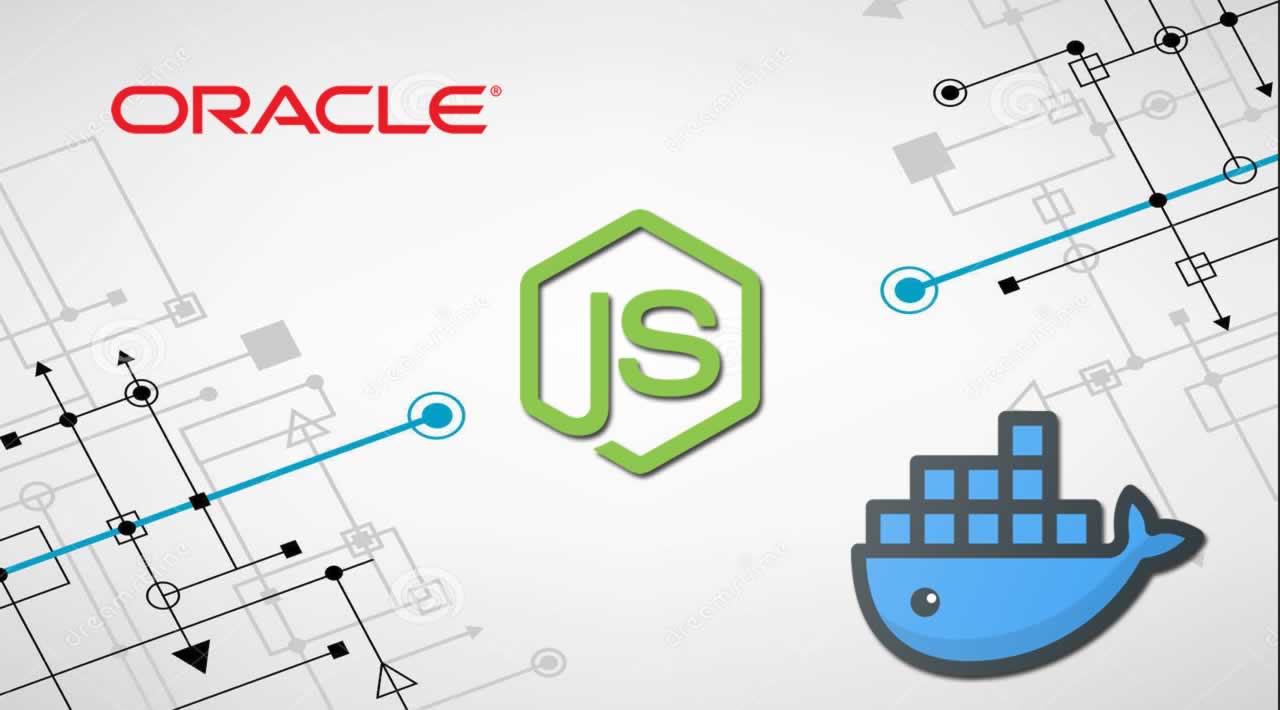How to Connect NodeJS App in Docker to Oracle Database
In this post, I’ll cover how to make a connection from a NodeJS application in a Docker container to your Oracle Database in three different scenarios.
- Typical Database connection.
- Database inside a different Docker container.
- Oracle Autonomous Transaction Processing Cloud Database.
Simple Test App
When attempting something new, I find it’s best to make sure all of the pieces that are not part of the new thing, are as simple as possible.
For my examples, I will be using a small NodeJS application that:
- Connects to the Oracle Database
- Runs a simple query.
- Prints the results to the console.
Create a new file named dbConfig.js to set the database connection information.
module.exports = {
user : process.env.NODE_ORACLEDB_USER,
password : process.env.NODE_ORACLEDB_PASSWORD,
connectString : process.env.NODE_ORACLEDB_CONNECTIONSTRING,
poolMax: 2,
poolMin: 2,
poolIncrement: 0
};
Create a new file named server.js used to test the connection.
const oracledb = require('oracledb');
const config = require('./dbConfig.js');
async function runTest() {
let conn;
try {
conn = await oracledb.getConnection(config);
const result = await conn.execute(
'select current_timestamp from dual'
);
console.log(result);
} catch (err) {
console.error(err);
} finally {
if (conn) {
try {
await conn.close();
} catch (err) {
console.error(err);
}
}
}
}
runTest();
Install the node-oracledb driver. (If you have any questions about the node-oracledb driver, you can find the answers here.)
npm install oracledb -s
Create environment variables for the connection information. (Replace my values with yours.)
export NODE_ORACLEDB_USER=NotMyRealUser
export NODE_ORACLEDB_PASSWORD=NotMyRealPassword
export NODE_ORACLEDB_CONNECTIONSTRING=192.168.0.44:1521/NotMyRealServiceName
Test the NodeJS application. You should see something similar to the following.
@OraBlaineOS:SimpleApp$ node server.js
{
metaData: [ { name: 'CURRENT_TIMESTAMP' } ],
rows: [ [ 2019-08-20T17:50:38.615Z ] ]
}
Create a Docker Container for the NodeJS App
Create a Dockerfile
FROM oraclelinux:7-slim
# Create app directory
WORKDIR /usr/src/app
# Copy the .js files from your host machine into the new app directory
ADD *.js ./
# Update Oracle Linux
# Install NodeJS
# Install the Oracle Instant Client
# Check that NodeJS and NPM installed correctly
# Install the OracleDB driver
RUN yum update -y && \
yum install -y oracle-release-el7 && \
yum install -y oracle-nodejs-release-el7 && \
yum install -y --disablerepo=ol7_developer_EPEL nodejs && \
yum install -y oracle-instantclient19.3-basic.x86_64 && \
yum clean all && \
node --version && \
npm --version && \
npm install oracledb && \
echo Installed
CMD ["node", "server.js"]
Build the image
docker build --no-cache --force-rm=true -t node_example .
Now that you have an image you’ll run a container and to connect it to:
Typical Oracle Database
docker run \
--name typical_node_example -it \
-e NODE_ORACLEDB_USER=$NODE_ORACLEDB_USER \
-e NODE_ORACLEDB_PASSWORD=$NODE_ORACLEDB_PASSWORD \
-e NODE_ORACLEDB_CONNECTIONSTRING=$NODE_ORACLEDB_CONNECTIONSTRING \
node_example
The container will run, execute the query, and stop. You should see something similar to this output.
{ metaData: [ { name: 'CURRENT_TIMESTAMP' } ],
rows: [ [ 2019-08-20T18:15:23.615Z ] ] }
An Oracle Database Inside a Docker Container
Created a Docker Network.
docker network create OrdsXeNet
You’ll use that same network to connect from the NodeJS container to the Oracle XE container.
First, change your NODE_ORACLEDB_CONNECTIONSTRING environment variable to use the Oracle XE container name.
export NODE_ORACLEDB_CONNECTIONSTRING=oracleXe:1521/xepdb1
Now, when you run a new docker container, you will attach it to the same Docker Network as the Oracle XE container.
docker run \
--name docker_network_node_example -it \
--network=OrdsXeNet \
-e NODE_ORACLEDB_USER=$NODE_ORACLEDB_USER \
-e NODE_ORACLEDB_PASSWORD=$NODE_ORACLEDB_PASSWORD \
-e NODE_ORACLEDB_CONNECTIONSTRING=$NODE_ORACLEDB_CONNECTIONSTRING \
node_example
The container will run, execute the query, and stop. You should see something similar to this output.
{ metaData: [ { name: 'CURRENT_TIMESTAMP' } ],
rows: [ [ 2019-08-27T16:42:16.122Z ] ] }
Since both containers are using the same Docker network, you do not need to open the port when you run the Oracle XE container. This is useful if you’d like to keep your database private inside the Docker environment.
Oracle Autonomous Transaction Processing Cloud Database
After you create an Oracle ATP Cloud Database, you’ll need to download the credentials file and extract it into a secure location.
For this database, you will be using an entry in the tnsnames.ora file to make the database connection. Change the NODE_ORACLEDB_CONNECTIONSTRING environment variable to use the tnsnames entry.
export NODE_ORACLEDB_CONNECTIONSTRING=projects_tp
Before you run the container, you need to modify the sqlnet.ora file found in the credentials directory. Change the wallet location to the value that will be mapped inside the Docker container.
WALLET_LOCATION = (SOURCE = (METHOD = file) (METHOD_DATA = (DIRECTORY="/wallet/")))
When you run the new container for the node app, you will map a volume from the directory where you extracted your credentials file to the internal container directory. Mapping a volume makes sure that there is not a copy of the credential files inside the Docker container.
-v /my/host/machine/credentials/directory:/wallet
Finally, when you run the new container, you will add an additional environment variable defining where the tns admin information is located.
-e TNS_ADMIN=/wallet
The full command looks like this:
docker run \
--name cloud_atp_node_example -it \
-v /my/host/machine/credentials/directory:/wallet \
-e NODE_ORACLEDB_USER=$NODE_ORACLEDB_USER \
-e NODE_ORACLEDB_PASSWORD=$NODE_ORACLEDB_PASSWORD \
-e NODE_ORACLEDB_CONNECTIONSTRING=$NODE_ORACLEDB_CONNECTIONSTRING \
-e TNS_ADMIN=/wallet \
-p 3000:3000 \
node_example
The container will run, execute the query, and stop. You should see something similar to this output.
{ metaData: [ { name: 'CURRENT_TIMESTAMP' } ],
rows: [ [ 2019-08-27T18:21:26.298Z ] ] }
Same Docker Image for all of the Examples
You may have noticed that you only built the Docker image once at the beginning of the post. The application in the Docker image uses environment variables to connect to the database. This allows you to run the same application in one or more containers and each container can connect to different Oracle Databases without having to rebuild the image.
#node-js #docker #kubernetes #cloud #web-development
